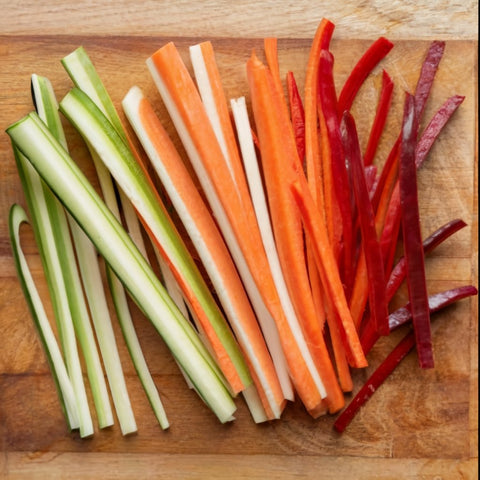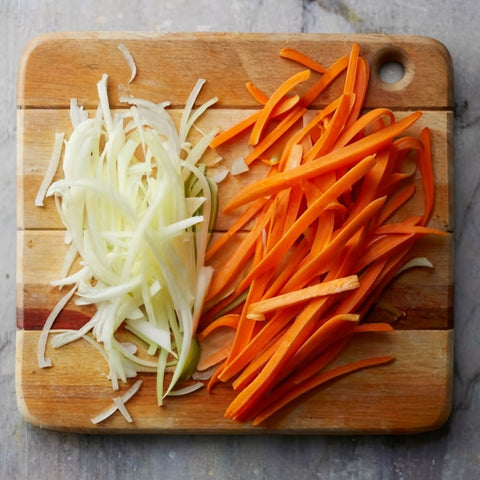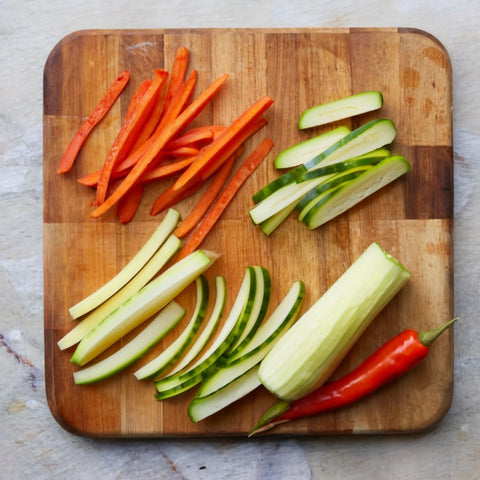Have you ever wondered how professional chefs create those perfect, thin strips of carrots or zucchini that make dishes look like works of art? That’s the magic of the julienne cut!
The julienne cut is a classic French method of chopping vegetables and fruits into matchstick-style pieces. The julienne cut stands as a testament to precision and artistry. This technique, originating from French cuisine, involves turning ordinary vegetables into delicate, uniform strips that elevate the visual appeal and texture of any dish. Whether you're a seasoned chef or a passionate home cook, mastering the julienne cut is a skill that can take your culinary creations to new heights. In this comprehensive guide, we will delve into every aspect of this technique, from the basics to advanced tips, ensuring you become a julienne cut maestro.
Don’t worry—it’s easier than you think, especially with a few tricks and tools up your sleeve. Whether you’re plating up a crisp salad or crafting a stunning garnish, this guide will teach you how to nail the technique every time.

With this simple step-by-step Julienne Cut guide, you will be a French knife technique master in practically no time!
Julienne veggies can be challenging, and it requires a lot of patience. Julienne veggies makes your salads, stir fries, side decorations and dishes very appetizing. Julienned vegetables can be a great addition to your recipes. You can make julienne ribbons from carrots to cucumbers and zucchini to bell peppers in fine, thin strips.
As a food enthusiast with years of experience, I can attest to the transformative power of the julienne cut in the culinary world. It's a technique that not only enhances the visual appeal of a dish but also elevates its overall taste and texture. The precision required in achieving uniform strips is akin to an art form, and when done right, it can truly set a dish apart. I've had the pleasure of incorporating julienne cuts into a myriad of recipes, from vibrant salads to hearty stir-fries, and the results have always been nothing short of spectacular. The julienne cut adds a level of sophistication to any dish, making it a staple in my culinary repertoire. So, for any aspiring chef or passionate home cook, mastering this technique is a worthwhile endeavor that will undoubtedly take your culinary creations to a whole new level of excellence.
When I eventually came to discover the julienne cut method I understood how much this technique is super easy, even for home cooks!
What Is a Julienne Cut, and Why Does It Matter?
The julienne cut is all about precision and style. It involves slicing vegetables or fruits into thin, uniform strips—usually 2-3 inches long and 1/16 to 1/8 inch thick. Not only does this cut make your dishes look fancy, but it also helps ingredients cook evenly and adds a delightful crunch to raw dishes.
Why It’s Awesome: A julienne cut makes your food look Instagram-worthy while boosting the texture and flavor of every bite. Plus, it’s a skill that every home chef should have in their toolkit!
The Secret Tools for Perfect Julienning
Sure, a knife works just fine. But let’s be honest—not everyone has the time (or patience) to make those perfect matchsticks by hand. That’s where the julienne peeler and mandoline slicer steal the show.
1. Julienne Peeler: The Everyday Hero
If you’re looking for speed and simplicity, the julienne peeler is your best friend. It’s compact, easy to use, and ideal for soft vegetables like zucchini, cucumbers, and carrots. Just run the peeler down your vegetable, and voilà—perfect strips in seconds!
The big advantage of a julienne peeler is its ability to create thin strips more efficiently and effortlessly. A julienne peeler can cut almost all kinds of vegetables easily. Whether it is large or hard. The julienne peeler has much more outcomes when it comes for home use. It’s a versatile tool and you can peel veggies into thin ribbons, making high quality salads and side dishes. In addition, when it comes to cleaning, the julienne peeler is much easier to clean.
Why We Love It:
- Super affordable and beginner-friendly.
- Great for quick meals when you’re short on time.
2. Mandoline Slicer: The Pro’s Choice
For those who want precision and versatility, a mandoline slicer is a must-have. With its adjustable blades, you can switch between julienne, waffle, and standard slices. It’s perfect for harder vegetables like potatoes, sweet potatoes, or beets.
Why It’s Worth It:
- Consistent, professional-grade results.
- Cuts prep time in half (and who doesn’t love that?).
How to Julienne Cut: Step-by-Step Methods
Using a Julienne Peeler (Fast & Easy)
- Wash and peel your vegetable.
- Hold the vegetable firmly and run the peeler down its length.
- Repeat until you’ve turned the entire vegetable into beautiful matchsticks.
Pro Tip: This works best for veggies like zucchini, carrots, and cucumbers.

Using a Mandoline Slicer (Precision at Its Best)
- Adjust the mandoline blade to the julienne setting.
- Secure the vegetable with the safety guard (no one likes a sliced finger).
- Slide the vegetable along the blade to create even strips.
Pro Tip: For extra safety, wear a cut-resistant glove.

Knife Method (For the Purists)
If you prefer the old-school way, here’s how to do it:
- Trim and peel your vegetable.
- Square off the sides to create a rectangular block.
- Slice into thin planks, then stack and cut into strips.
Heads Up: This method takes practice, but it’s great if you don’t have the tools.

Expert Tips and Tricks for Mastering the Julienne Cut
-
Get Comfortable with Knife Skills
Great julienne cuts start with good knife skills. Make sure you’re holding the knife correctly, with a firm grip and your fingers tucked safely out of the way (a “claw” grip works wonders). Don’t rush—focus on slow, deliberate cuts to build confidence and accuracy. Even professional chefs didn’t get it perfect on their first try! -
Keep That Knife Razor Sharp
A dull knife is your worst enemy when it comes to julienne cutting. Not only does it make the job harder, but it also increases the risk of slips and accidents. A sharp knife glides through vegetables cleanly, giving you those crisp, uniform strips. Invest in a good sharpening tool or take your knives to a professional every so often. Trust me, it’s worth it. -
Stabilize Your Vegetables
Wobbly veggies are a recipe for uneven cuts (and frustration). Create a flat base by slicing off one side of the vegetable before you start. This little trick keeps everything steady and makes cutting a whole lot easier. -
Practice Makes Perfect
Let’s be real—your first few julienne cuts might look a little…rustic. That’s totally fine! Start with larger vegetables like potatoes or zucchini. Once you get the hang of it, move on to smaller, firmer ones like carrots. The more you practice, the quicker and more precise you’ll become. -
Safety First: Use Gloves If Needed
If you’re nervous about cutting yourself, especially with tools like mandolines, grab a pair of cut-resistant gloves. They’re a simple way to boost your confidence while staying safe.
Why a Sharp Knife Changes Everything
A sharp knife isn’t just about looking cool in the kitchen—it’s absolutely essential for perfect julienne cuts. Here’s why:
- Clean, Precise Cuts: A sharp knife slices through vegetables like butter, making it easy to get those perfect, uniform strips.
- Safety First: Believe it or not, dull knives are more dangerous because they require more force and are more likely to slip.
- Effortless Cutting: You’ll save time and energy when your knife is up to the task.
If you want to keep your knife in top shape, hone it regularly and sharpen it when needed. And please, don’t cut on glass cutting boards—they’re murder on your blades.
The Power of Practice and Precision
Nobody becomes a julienne master overnight, and that’s okay. Cutting vegetables into thin, uniform strips takes time and patience. Think of it like learning a new skill—you’re building muscle memory every time you practice.
- Start Slow: Begin with easier vegetables and don’t worry about speed. Speed will come naturally as your technique improves.
- Focus on Consistency: Aim for strips that are as uniform as possible. They’ll cook evenly and look great on the plate.
- Celebrate Progress: Even small improvements are a big win. Over time, you’ll notice your cuts getting straighter and more precise.
Mastering the julienne cut isn’t just about technique; it’s about building confidence. Take it one vegetable at a time, and before you know it, you’ll be slicing like a pro!
What Vegetables Work Best?
- Carrots: Brighten up your stir-fries and salads.
- Zucchini: Perfect for zoodles or raw dishes.
- Bell Peppers: Add a pop of color to any plate.
- Potatoes: Crispy shoestring fries, anyone?
- Beets & Radishes: Beautiful in salads or as garnishes.
FAQs About Julienne Cuts
Why should I use a julienne peeler or mandoline slicer?
These tools save time and effort while delivering consistent, professional results. They’re perfect for beginners and pros alike.
What’s the difference between julienne and regular slicing?
Julienne strips are much thinner and uniform, which makes them ideal for even cooking and fancy presentations.
Can I julienne without any tools?
Yes, but it takes practice. Using a knife works well, but it’s slower and harder to achieve perfect results.
Where to Use Your Julienned Vegetables
- Salads: Add crunch and visual appeal.
- Stir-Fries: Thin strips cook quickly and evenly.
- Sushi & Spring Rolls: Create clean, colorful fillings.
- Soup Toppings: Add a gourmet touch to broths.
- Shoestring Fries: Slice potatoes thinly for crispy fries.
Why Trust Us?
Here at My Kitchen Gadgets, we’re all about making cooking fun, easy, and delicious. With years of experience testing kitchen tools and techniques, we bring you tips that work in real life. Our mission is to help you become the chef you’ve always wanted to be.
Ready to Upgrade Your Kitchen Skills?
It’s time to invest in tools that make life easier. Grab a julienne peeler for quick cuts or a mandoline slicer for precision and versatility. Trust us—you’ll wonder how you ever cooked without them!






